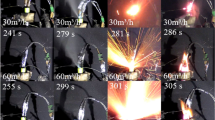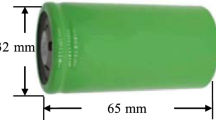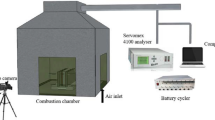Abstract
As a common safety issue, thermal runaway (TR) of lithium-ion batteries (LIBs) may propagate to adjacent batteries and grow into a large-scale fire, in a multi-cell array or pack. A dynamic pressure chamber was developed to investigate the effect of airflow rates on TR propagation among pouch LIBs under the ambient pressures of 95 kPa and 20 kPa. The results indicate that the ununiform heating and asynchronous trigger of TR between two side of battery are occurred when the TR propagated from TR battery with high temperature over 800°C. The TR propagation can be slowed down under low ambient pressure, e.g., propagation time under 20 kPa is 83 s slightly slower than 73 s under 95 kPa with same airflow rate of 60 L/s. As the increase of airflow rate under 20 kPa from 60 L/s to 150 L/s, peak heat release rate and total heat release increase from 6.1 kW to 29 kW, and from 287 kJ to 872 kJ, and TR fire behaviours also are intensified, which can further shorten the TR propagation time from 83 s to 71 s, through heat feedback from TR combustion fire. The release of toxic/flammable or potentially explosive gases, such as 3620 ppm for total hydrocarbons, 0.97% for CO under 20 kPa during TR propagation needs to be paid attentions especially with low airflow rate. Airflow rate under low pressure condition of 20 kPa has a great impact on the TR propagation, and some mitigation measures and protection design about the LIB module used under low pressure environments should be taken.















Similar content being viewed by others
Abbreviations
- \({B}_{i}\) :
-
The ith battery
- \({\rho }_{{O}_{2}}\) :
-
The mass concentration of oxygen (g/cm3)
- \(P\) :
-
The pressure (kPa)
- MO2 :
-
Molar mass of O2
- i :
-
i = 1, 2, 3, 4, 5, 6
- n :
-
The time index of data
- t :
-
The time (s)
- T :
-
Temperature (°C)
- R :
-
Molar gas constant
- A :
-
The cross-sectional area of the flue pipe (m2)
- \({k}_{c}\) :
-
The shape factor of the velocity distribution in the flue pipe
- \(f\left(Re\right)\) :
-
The Reynolds number correction function
- \(\Delta P\) :
-
The differential pressure of the flue pipe (Pa)
- \(\eta\) :
-
The oxidation combustion efficiency
- \(\Delta Q\) :
-
The change in energy (kJ)
- C :
-
Average specific heat capacity of battery (J kg−1 K−1)
- \(\Delta T\) :
-
The change in temperature (°C)
- \(Q\) :
-
The energy (kJ)
- m :
-
Mass
- dec :
-
Decomposition
- ele :
-
Stored electrical energy
- ext :
-
External electrical resistance
- feed :
-
Heat feedback
- loss :
-
Heat loss
- com :
-
Combustion
- b :
-
Battery after TR
- g :
-
Gas emissions
- s :
-
Solid ejections
- tot :
-
Total room temperature (°C)
- \({T}_{0}\) :
-
Room temperature (°C)
- con:
-
The energy conduction
- k :
-
The coefficient relative to the distance of temperature gradient
- λ :
-
The value of thermal conductivity (W m−1 K−1)
- ν :
-
The wind speed (m/s)
References
Sripad S, Bills A, Viswanathan V (2021) A review of safety considerations for batteries in aircraft with electric propulsion. MRS Bull 46:435–442
NTSB (2014) Auxiliary Power Unit Battery Fire. Japan Airlines Boeing, Boston, pp 787–788
Wang Q, Ping P, Zhao X, Chu G, Sun J, Chen C (2012) Thermal runaway caused fire and explosion of lithium ion battery. J Power Sources 208:210–224
Sun L, Wei C, Guo D, Liu J, Zhao Z, Zheng Z, Jin Y (2020) Comparative study on thermal runaway characteristics of lithium iron phosphate battery modules under different overcharge conditions. Fire Technol 56:1555–1574
Federal Aviation Administration (2021) Events with smoke, fire, extreme heat or explosion involving lithium batteries. Federal Aviation Administration, Washington, DC
Niu H, Chen C, Ji D, Li L, Li Z, Liu Y, Huang X (2020) Thermal-runaway propagation over a linear cylindrical battery module. Fire Technol 56:2491–2507
Wang Q, Huang P, Ping P, Du Y, Li K, Sun J (2017) Combustion behavior of lithium iron phosphate battery induced by external heat radiation. J Loss Prev Process Ind 49:961–969
Feng X, Lu L, Ouyang M, Li J, He X (2016) A 3D thermal runaway propagation model for a large format lithium ion battery module. Energy 115:194–208
Feng X, He X, Ouyang M, Lu L, Wu P, Kulp C, Prasser S (2015) Thermal runaway propagation model for designing a safer battery pack with 25 Ah LiNi Co Mn O2 large format lithium ion battery. Appl Energy 154:74–91
Lamb J, Orendorff CJ, Steele LAM, Spangler SW (2015) Failure propagation in multi-cell lithium ion batteries. J Power Sources 283:517–523
Jia YK, Xu J (2020) Modeling of thermal propagation based on two cylindrical lithium-ion cells. J Electrochem Energy Convers Storage. https://doi.org/10.1115/1.4045199
Feng X, Sun J, Ouyang M, Wang F, He X, Lu L, Peng H (2015) Characterization of penetration induced thermal runaway propagation process within a large format lithium ion battery module. J Power Sources 275:261–273
Ouyang D, Liu J, Chen M, Weng J, Wang J (2018) An experimental study on the thermal failure propagation in lithium-ion battery pack. J Electrochem Soc 165:A2184–A2193
Wang L, Yin S, Xu J (2019) A detailed computational model for cylindrical lithium-ion batteries under mechanical loading: From cell deformation to short-circuit onset. J Power Sources 413:284–292
Said AO, Lee C, Stoliarov SI, Marshall AW (2019) Comprehensive analysis of dynamics and hazards associated with cascading failure in 18650 lithium ion cell arrays. Appl Energy 248:415–428
Huang Z, Liu J, Zhai H, Wang Q (2021) Experimental investigation on the characteristics of thermal runaway and its propagation of large-format lithium ion batteries under overcharging and overheating conditions. Energy 233:121103
Wilke S, Schweitzer B, Khateeb S, Al-Hallaj S (2017) Preventing thermal runaway propagation in lithium ion battery packs using a phase change composite material: an experimental study. J Power Sources 340:51–59
Gao S, Feng X, Lu L, Kamyab N, Du J, Coman P, White RE, Ouyang M (2019) An experimental and analytical study of thermal runaway propagation in a large format lithium ion battery module with NCM pouch-cells in parallel. Int J Heat Mass Transf 135:93–103
Börger A, Mertens J, Wenzl H (2019) Thermal runaway and thermal runaway propagation in batteries: what do we talk about? J Energy Storage 24:100649
Quanyi L, Xiaoying Y, Xu H (2020) Effect of different arrangement on thermal runaway characteristics of 18650 lithium ion batteries under the typical pressure in civil aviation transportation. Fire Technol 56:2509–2523
Chen X, Zhang X, Wang H, Jia J, Xie S, Zhi M, Fu J, Sun Q (2021) Influence of ambient pressure and heating power on the thermal runaway features of lithium-ion battery. J Electrochem Energy Convers Storage. https://doi.org/10.1115/1.4049316
Chen W, Jiang J, Wen J (2020) Thermal runaway induced by dynamic overcharge of lithium-ion batteries under different environmental conditions. J Therm Anal Calorim 146:855–863
Chen M, Liu J, Lin X, Huang Q, Yuen R, Wang J (2016) Combustion characteristics of primary lithium battery at two altitudes. J Therm Anal Calorim 124:865–870
Chen M, Liu J, He Y, Yuen R, Wang J (2017) Study of the fire hazards of lithium-ion batteries at different pressures. Appl Therm Eng 125:1061–1074
Chen M, Ouyang D, Weng J, Liu J, Wang J (2019) Environmental pressure effects on thermal runaway and fire behaviors of lithium-ion battery with different cathodes and state of charge. Process Saf Environ Prot 130:250–256
Fu Y, Lu S, Shi L, Cheng X, Zhang H (2018) Ignition and combustion characteristics of lithium ion batteries under low atmospheric pressure. Energy 161:38–45
Xie S, Ren L, Yang X, Wang H, Sun Q, Chen X, He Y (2020) Influence of cycling aging and ambient pressure on the thermal safety features of lithium-ion battery. J Power Sources 448:1181–1189
Xie S, Ren LX, Gong YZ, Li MH, Chen XT (2020) Effect of charging/discharging rate on the thermal runaway characteristics of lithium-ion batteries in low pressure. J Electrochem Soc 167:8
Feng X, Ouyang M, Liu X, Lu L, Xia Y, He X (2018) Thermal runaway mechanism of lithium ion battery for electric vehicles: a review. Energy Storage Mater 10:246–267
Sun J, Li J, Zhou T, Yang K, Wei S, Tang N, Dang N, Li H, Qiu X, Chen L (2016) Toxicity, a serious concern of thermal runaway from commercial Li-ion battery. Nano Energy 27:313–319
Chow WK, Han SS (2011) Heat release rate calculation in oxygen consumption calorimetry. Appl Therm Eng 31:304–310
Golubkov AW, Fuchs D, Wagner J, Wiltsche H, Stangl C, Fauler G, Voitic G, Thaler A, Hacker V (2014) Thermal-runaway experiments on consumer Li-ion batteries with metal-oxide and olivin-type cathodes. RSC Adv 4:3633–3642
Quintiere JG (2021) More on methods to measure the energetics of lithium ion batteries in thermal runaway. Fire Saf J 124:103382
Lyon RE, Walters RN (2016) Energetics of lithium ion battery failure. J Hazard Mater 318:164–172
Sun Q, Liu H, Zhi M, Chen X, Lv P, He Y (2022) Thermal characteristics of thermal runaway for pouch lithium-ion battery with different state of charges under various ambient pressures. J Power Sources 527:231175
Quintiere JG (2020) On methods to measure the energetics of a lithium ion battery in thermal runaway. Fire Saf J 111:102911
Funding
Sichuan Science and Technology Program (Grant No. 2022YFG0215) to Maoyong Zhi (Grant No. 2022YFG0236) to Song Xie; General Program of Civil Aviation Flight University of China (Grant No. J2020-113) to Qiang Sun
Author information
Authors and Affiliations
Corresponding authors
Additional information
Publisher's Note
Springer Nature remains neutral with regard to jurisdictional claims in published maps and institutional affiliations.
Supplementary Information
Below is the link to the electronic supplementary material.
Rights and permissions
About this article
Cite this article
Sun, Q., Liu, H., Zhi, M. et al. Lithium-Ion Battery Thermal Runaway Propagation Characteristics Under 20 kPa with Different Airflow Rates. Fire Technol 59, 1157–1179 (2023). https://doi.org/10.1007/s10694-022-01281-8
Received:
Accepted:
Published:
Issue Date:
DOI: https://doi.org/10.1007/s10694-022-01281-8




